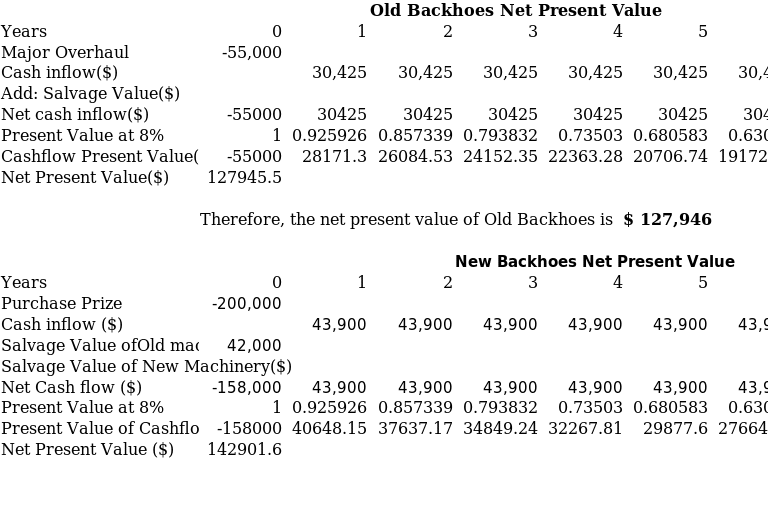Net Present Value
 . In this case, “Rt” represents the net cash flow at a specified time “, t”, while “i” represents the discount rate, and “t” is the time of the cash flow (Noch & Kusto, 2018). NPV also enables a manager to compare two different projects and decide which ones to pursue.
. In this case, “Rt” represents the net cash flow at a specified time “, t”, while “i” represents the discount rate, and “t” is the time of the cash flow (Noch & Kusto, 2018). NPV also enables a manager to compare two different projects and decide which ones to pursue.
In the case presented, the excel calculations show that the net present value of old backhoes is $ 127,945.52 while that of new backhoes is $ 142901.65. This shows that both net present values are positive, meaning that all expected earnings are higher compared to the anticipated costs. Therefore, neither of the two options presented to the company will bring losses. However, considering that the net present value of the new backhoes is greater than that of old backhoes, the company should purchase the new equipment.
Payback Period

Payback method is an evaluation method used to determine the amount of time it will take to recover the initial investment. Several business projects and plans for an organization require capital. However, when investing a certain amount of capital into the project, it will take a specific period before the profits from the project offset the capital investment (Konstantin and Konstantin, 2018). This implies that if the project does not make enough profit to cover the start-up costs, that investment is not worthwhile. On the other hand, the project that offers the shortest payback period is most likely the best possible investment as it offers a lower risk.
In this case, calculating the payback periods for both the new and old backhoes enables one to analyze the cash flow of the two projects. It will also give a rough estimate of the time the firm will take to recover the cost of each project. According to the calculations, the payback period for keeping the old backhoes is 1.81, while the payback period for purchasing the new equipment is 3.6. This means that the firm will take longer to pay back the cost of purchasing new backhoes. On the other hand, if it decides to keep the old ones, the company will take almost half the time it would have taken to recover the costs of the new equipment.
Profitability index

The profitability index is used to measure how attractive investment or project is. The higher the profitability index, the more attractive the investment (Konstantin and Konstantin, 2018). Similarly, an investment with a low profitability index means that there is a low value created per unit of investment. In the scenario provided, the profitability index of old backhoes is 3.33 while that of new backhoes = 1.9. This shows that the company should continue using the old backhoes since they provide a higher profitability index compared to purchasing new ones.
Intangible benefits that could influence the decision (to either continue using the old equipment or purchase new ones) include the ease of use. Since the employees are already familiarized with the old equipment, they will not have to learn new skills to use new equipment. Therefore, deciding to keep the old equipment would contribute to the employees’ ease of use. Another intangible benefit is the technology that comes with purchasing new backhoes. The new tools are faster, provide comfort features for employees, and ensure more accurate trench digging. This makes it more attractive as it offers improved technology. I believe that the firm should continue using the old backhoes rather than buying new ones. This is because the calculations show that using the old ones guarantees more profit compared to purchasing new ones. Therefore, this option is more attractive and offers more benefits to the organization.
References
Konstantin, P., & Konstantin, M. (2018). Investment appraisal methods. In: Power and energy systems engineering economics (pp. 39-64). Springer. Web.
Noch, T., & Kusto, Z. (2018). Analysis of the incremental cost method and the net present value method applied in the energy sector. In E3S Web of Conferences (Vol. 49, p. 00075). EDP Sciences. Web.